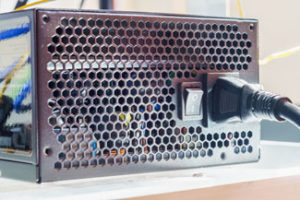On December 20, 2020, the current standard for several ITE (Information Technology Equipment) components will be withdrawn. For users of standards such as 61010-1, UL 508A, 60335 -1 and other end product standards, this may seem inconsequential; however, many manufacturers use components that are approved to 60950-1 in their end product that is approved to these other standards. So how is it that this can cause problems?

Components are approved to relevant standards. Occasionally the most relevant standard is also an end product standard. 60950-1, for example has been used to approve components such as storage devices, displays, and even power supplies. If these components are used in a product being certified to another end product standard such as the standard for laboratory equipment (61010-1), manufacturers may not immediately see the link.
Let’s consider the case of an ITE power supply that is approved to 60950-1. This power supply can be used in other end products that are different from those being evaluated to 60950-1, such as a laboratory instrument. While additional tests might be required by the end product standard such as 61010-1, the component would be accepted, assuming it passes those additional requirements. After December 20, 2020, the ITE power supply that was approved to 60950-1 will still have a valid report. Some of the issues that might arise are as followed:
- Parts obsolescence – the power supply manufacturer will not be able to update their report if components become discontinued. Rather than being able to substitute and add an alternate component to their report, the manufacturer will not be able to update their 60950 report after December 20, 2020. The manufacturer will be forced to move to 62368-1 or another standard. This may result in changes to the power supply and even a model variance which will no longer match the model number in your end product report.
- Presumption of conformity – This is primarily an issue for those end product manufacturers shipping in to the EU, but rely on the sDoC (supplier Declaration of Conformity) for the component being used in their end product. Manufacturers can rely on the sDoC of components for compliance, however the presumption of conformity for those components produced after December 20, 2020 and based on 60950-1 is lost after the standard is withdrawn on December 20, 2020. This places additional responsibility on the end product manufacturer to ensure compliance of not only the end product, but the components they are using that no longer meet a relevant harmonized standard.
- Product updates to certified products – End product manufacturers could be adversely impacted if they are making simple updates to their report and an unrelated component is discovered to be approved to a withdrawn standard… During the report update, the entire report is reviewed as part of the responsibility of the certification body (e.g. Nationally Recognized Test Laboratory – NRTL). If there is a component approved to a withdrawn standard, that component must be updated as well. This may require additional testing or design changes for those components evaluated to 60950-1.
So what should manufacturers do?
- Check your reports for any critical safety components approved to 60950-1. If there are components citing 60950-1 as the relevant standard for the component, contact your supplier and check if they have updated the component to another standard or if they are planning to discontinue the component.
- Determine the potential impact to the life cycle of your product. If you are no longer ordering material for your product and simply building out existing inventory, then you may not need to worry about updating your report.
Professional Testing is ready to help you if you have any questions on how the withdrawal of 60950-1 may impact your business or end products. If you are uncertain about how the withdrawal will impact you, contact one of our engineers and we will be glad to review and discuss a strategy for ensuring your continued compliance.

